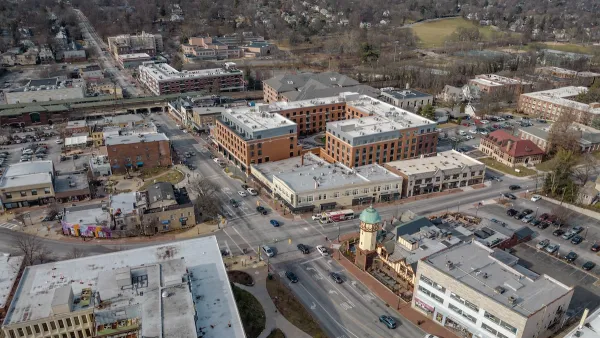This article from City Journal looks at the anti-modernist architect Leon Krier's plan for remaking suburbs into self-contained towns.
"What makes Krier new, and so important for us at the critical point that we have now reached-when everyone apart from professional architects recognizes that cities, to flourish, require a centripetal force to replace the centrifugal-is that he has a clear and persuasive remedy, one that town planners and builders everywhere could easily adopt and that citizens would embrace immediately if it were put to the vote."
"Krier's solution is to replace the "downtown plus suburbs" system with that of the polycentric settlement. If people move out, then let it be to new urban centers, with their own public spaces, public buildings, and places of work and leisure: let the new settlements grow, as Poundbury has grown next to Dorchester, not as suburbs but as towns. For then they will recapture the true goal of settlement, which is the human community in a place that is 'ours' rather than individual plots scattered over a place that is no one's. The towns will create a collection of somewheres instead of an ever-expanding nowhere. This solution has a precedent: the city of London grew next to the city of Westminster in friendly competition, and the residential areas of Chelsea, Kensington, Bloomsbury, and Whitechapel arose as autonomous villages rather than as spillovers from the existing centers."
"The only thing needed to achieve this effect, Krier argues, is a master plan. By this, he means not one of those sinister experiments in social engineering that appealed to the modernists but a simple set of rules within which people can make the choices best suited to their needs. Krier's master plan involves an overall layout, a street plan for each quarter, and rules governing such things as the shape of plots, the number of floors permitted in buildings (five, in Krier's view, is the natural maximum), and the materials and technical configurations to which structures should conform. His aim is to control the quality of 'normal, regular and inevitable building.'"
FULL STORY: Cities for Living

Analysis: Cybertruck Fatality Rate Far Exceeds That of Ford Pinto
The Tesla Cybertruck was recalled seven times last year.

National Parks Layoffs Will Cause Communities to Lose Billions
Thousands of essential park workers were laid off this week, just before the busy spring break season.

Retro-silient?: America’s First “Eco-burb,” The Woodlands Turns 50
A master-planned community north of Houston offers lessons on green infrastructure and resilient design, but falls short of its founder’s lofty affordability and walkability goals.

Test News Post 1
This is a summary

Analysis: Cybertruck Fatality Rate Far Exceeds That of Ford Pinto
The Tesla Cybertruck was recalled seven times last year.

Test News Headline 46
Test for the image on the front page.
Urban Design for Planners 1: Software Tools
This six-course series explores essential urban design concepts using open source software and equips planners with the tools they need to participate fully in the urban design process.
Planning for Universal Design
Learn the tools for implementing Universal Design in planning regulations.
EMC Planning Group, Inc.
Planetizen
Planetizen
Mpact (formerly Rail~Volution)
Great Falls Development Authority, Inc.
HUDs Office of Policy Development and Research
NYU Wagner Graduate School of Public Service




























